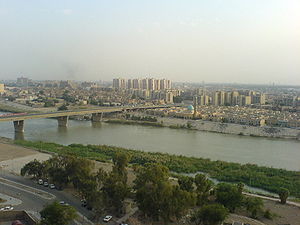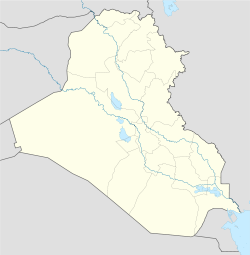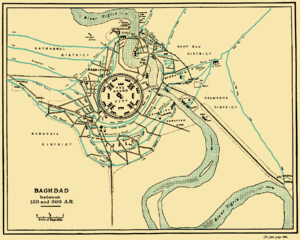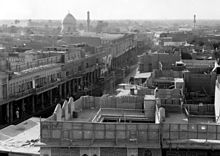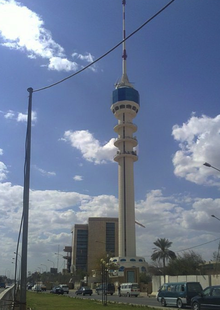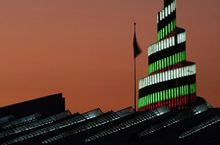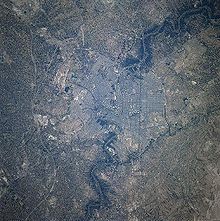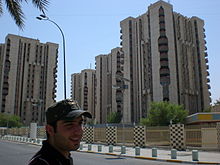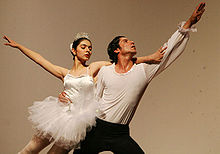
Baghdad
Did you know...
SOS Children offer a complete download of this selection for schools for use on schools intranets. SOS Children is the world's largest charity giving orphaned and abandoned children the chance of family life.
| Baghdad | |
|---|---|
| — Capital city — | |
| بغداد (Baġdād) |
|
| Baghdad overlooking the Tigris | |
|
|
|
| Coordinates: 33°20′00″N 44°26′00″E | |
| Country | |
| Governorate | Baghdad |
| Established | 762 AD |
| Founder | Abu Jafar al-Mansur |
| Government | |
| • Type | Mayor-council |
| • Body | Baghdad City Advisory Council |
| • Mayor | Saber Nabet Al-Essawi |
| Area | |
| • Total | 204.2 km2 (78.8 sq mi) |
| Elevation | 34 m (112 ft) |
| Population | |
| • Estimate (2011) | 7,216,040 |
| • Rank | 1st |
| Demonym | Baghdadi |
| Time zone | Arabia Standard Time ( UTC+3) |
| • Summer ( DST) | No DST ( UTC) |
| Postal code | 10001 to 10090 |
| Website | http://www.baghdad.gov.iq/ |
Baghdad (Arabic: بغداد, Baġdād, IPA: [bæɣˈdæːd]) is the capital of the Republic of Iraq, as well as the coterminous Baghdad Province. The population of Baghdad as of 2011 is approximately 7,216,040, making it the largest city in Iraq, the second largest city in the Arab World (after Cairo, Egypt), and the second largest city in Western Asia (after Tehran, Iran).
Located along the Tigris River, the city was founded in the 8th century and became the capital of the Abbasid Caliphate. Within a short time of its inception, Baghdad evolved into a significant cultural, commercial, and intellectual centre for the Islamic World. This in addition to housing several key academic institutions (e.g. House of Wisdom) garnered the city a worldwide reputation as the "Centre of Learning". Throughout the High Middle Ages, Baghdad was considered to be the largest city in the world with an estimated population of 1,200,000 people. The city was largely destroyed at the hands of the Mongol Empire in 1258, resulting in a decline that would linger through many centuries due to frequent plagues and multiple successive empires. With the recognition of Iraq as an independent state (formerly the British Mandate of Mesopotamia) in 1938, Baghdad gradually regained some of its former prominence as a significant centre of Arabic culture.
In contemporary times the city has often faced severe infrastructural damage, most recently due to the American-led foreign occupation in March 2003 that lasted until December 2011 and the subsequent sectarian violence. In recent years the city has been frequently subjected to insurgency activities and terrorist attacks. Though the nation continues to work toward rebuilding and reconciliation, as of 2012 Baghdad continues to be listed as one of the least hospitable places in the world to live and was ranked by Mercer as the worst of 221 major cities as measured by quality-of-life.
Toponym
The name Baghdad is pre-Islamic and its origins are unclear, but it is related to previous settlements, which did not have any political or commercial power. The name has been found as Baghdadu on Assyrian cuneiform records of the 9th century BC, and on Babylonian bricks bearing the Royal Seal of King Nebuchadnezzar (6th century BC).
When the Abbasid caliph al-Mansur founded a completely new city for his capital, he chose the name Madinat al-Salaam or City of Peace. This was the official name on coins, weights, and other official usage, although the common people continued to use the old name. By the 11th century, "Baghdad" became almost the exclusive name for the world-renowned metropolis.
There are several rival theories as to the etymology of the specific name Baghdad. The most widely accepted among these is that the name is a Middle Persian compound of Bag "god" + dād "given", translating to "God-given" or "God's gift", from which comes Modern Persian Baɣdād. This in turn can be traced to Old Persian. A less probable guess is the Persian compound Bāğ "garden" + dād "fair", translating to "The fair garden".
History
Foundation
After the fall of the Persian Sassanid empire, the victorious Muslim rulers wanted their own capital. Choosing a site north of the Persian capital of Ctesiphone, on 30, July 762 the caliph Al Mansur commissioned the construction of the city and it was built under the supervision of the Barmakids. Mansur believed that Baghdad was the perfect city to be the capital of the Islamic empire under the Abbasids. Mansur loved the site so much he is quoted saying, "This is indeed the city that I am to found, where I am to live, and where my descendants will reign afterward".
The city's growth was helped by its location, which gave it control over strategic and trading routes, along the Tigris. A reason why Baghdad provided an excellent location was the abundance of water and the dry climate. Water exists on both north and south ends of the city gates, allowing all households to have a plentiful supply, which was very uncommon during this time.
Baghdad eclipsed Ctesiphon, the capital of the Persian Empire, which was located some 30 km (19 mi) to the southeast. Today, all that remains of Ctesiphon is the shrine town of Salman Pak, just to the south of Greater Baghdad. Ctesiphon itself had replaced and absorbed Seleucia, the first capital of the Seleucid Empire. Seleucia had earlier replaced the city of Babylon.
In its early years the city was known as a deliberate reminder of an expression in the Qur'an, when it refers to Paradise. Four years before Baghdad's foundation, in 758, Mansur assembled engineers, surveyors, and art constructionists from around the world to come together and draw up plans for the city. Over 100,000 construction workers came to survey the plans; many were distributed salaries to start the building of the city. July was chosen as the starting time because two astrologers, Naubakht Ahvaz and Mashallah, believed that the city should be built under the sign of the lion, Leo. Leo is associated with fire and symbolises productivity, pride, and expansion.
The bricks used to make the city were 18 inches (460 mm) on all four sides. Abu Hanifa was the counter of the bricks and he developed a canal, which brought water to the work site for the use of both human consumption and the manufacturing of the bricks. Marble was also used to make buildings throughout the city, and marble steps led down to the river's edge.
The basic framework of the city consists of two large semicircles about 19 km (12 mi) in diameter. The city was designed as a circle about 2 km in diameter, leading it to be known as the "Round City". The original design shows as single ring of residential and commercial structures along the inside of the city walls, but the final construction added another ring inside the first. Within the city there were many parks, gardens, villas, and promenades. In the centre of the city lay the mosque, as well as headquarters for guards. The purpose or use of the remaining space in the centre is unknown. The circular design of the city was a direct reflection of the traditional Persian Sasanian urban design. The Sasanian city of Gur in Fars, built 500 years before Baghdad, is nearly identical in its general circular design, radiating avenues, and the government buildings and temples at the centre of the city. This style of urban planning contrasted with Ancient Greek and Roman urban planning, in which cities are designed as squares or rectangles with streets intersecting each other at right angles.
The surrounding walls
The four surrounding walls of Baghdad were named Kufa, Basra, Khurasan, and Damascus; named because their gates pointed in the directions of these destinations. The distance between these gates was a little less than 1.5 miles (2.4 km). Each gate had double doors that were made of iron; the doors were so heavy it took several men to open and close them. The wall itself was about 44 m thick at the base and about 12 m thick at the top. Also, the wall was 30 m high, which included merlons, a solid part of an embattled parapet usually pierced by embrasures. This wall was surrounded by another wall with a thickness of 50 m. The second wall had towers and rounded merlons, which surrounded the towers. This outer wall was protected by solid glacis, which is made out of bricks and quicklime. Beyond the outer wall was a water-filled moat.
Golden Gate Palace
In the middle of Baghdad, in the central square was the Golden Gate Palace. The Palace was the residence of the caliph and his family. In the central part of the building was a green dome that was 39 m high. Surrounding the palace was an esplanade, a waterside building, in which only the caliph could come riding on horseback. In addition, the palace was near other mansions and officer's residences. Near the Gate of Syria a building served as the home for the guards. It was made of brick and marble. The palace governor lived in the latter part of the building and the commander of the guards in the front. In 813, after the death of caliph Al-Amin the palace was no longer used as the home for the caliph and his family. The roundness points to the fact that it was based on Arabic script. The two designers who were hired by Al-Mansur to plan the city's design were Naubakht, a Zoroastrian who also determined that the date of the foundation of the city would be astrologically auspicious, and Mashallah, a Jew from Khorasan, Iran.
The Abbasids and the round city
The Abbasid Caliphate was based on their being the descendants of the uncle of Muhammad and being part of the Quraysh tribe. They used Shi'a resentment, Khorasanian movement, and appeals to the ambitions and traditions of the newly conquered Persian aristocracy to overthrow the Umayyads. The Abbasids sought to combine the hegemony of the Arabic tribes with the imperial, court, ceremonial, and administrative structures of the Persians. The Abbasids considered themselves the inheritors of two traditions: the Arabian-Islamic (bearers of the mantle of Muhammad) and the Persian (successors to the Sassanid monarchs).
These two things are evident from the construction, which is modeled after Persian structures and the need of Mansur to place the capital in a place that was representative of Arab-Islamic identity by building the House of Wisdom, where ancient texts were translated from their original language, such as Greek, to Arabic. Mansur is credited with the " Translation Movement" for this. Further, Baghdad is also near the ancient Sassanid imperial seat of Ctesiphon on the Tigris River.
A centre of learning (8th to 13th centuries)
Within a generation of its founding, Baghdad became a hub of learning and commerce. The House of Wisdom was an establishment dedicated to the translation of Greek, Middle Persian and Syriac works. Scholars headed to Baghdad from all over the Abbasid empire, facilitating the introduction of Persian, Greek and Indian science into the Arabic and Islamic world at that time. Baghdad was likely the largest city in the world from shortly after its foundation until the 930s, when it was tied by Córdoba. Several estimates suggest that the city contained over a million inhabitants at its peak. Many of the One Thousand and One Nights tales are set in Baghdad during this period.
The end of the Abbasids in Baghdad
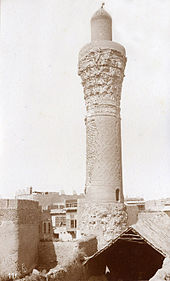
By the 10th century, the city's population was between 1.2 million and 2 million. Baghdad's early meteoric growth eventually slowed due to troubles within the Caliphate, including relocations of the capital to Samarra (during 808–819 and 836–892), the loss of the western and easternmost provinces, and periods of political domination by the Iranian Buwayhids (945–1055) and Seljuk Turks (1055–1135).
The Seljuks were a clan of the Oghuz Turks from the Siberian steppes that converted to the Sunni branch of Islam. In 1040, they destroyed the Ghaznavids, taking over their land and in 1055, Tughril Beg, the leader of the Seljuks, took over Baghdad. The Seljuks expelled the Buyids dynasty of Shiites that ruled for some time and took over power and control of Baghdad. They ruled as Sultans in the name of the Abbasid caliphs (they saw themselves as being part of the Abbasid regime) Tughril Beg saw himself as the protector of the Abbasid Caliphs.
In 1058, Baghdad was captured by the Fatimids under the Turkish general Abu'l-Ḥārith Arslān al-Basasiri, an adherent of the Ismailis along with the 'Uqaylid Quraysh. Not long before the arrival of the Saljuqs in Baghdad, al-Basasiri petitioned to the Fatimid Imam-Caliph al-Mustansir to support him in conquering Baghdad on the Ismaili Imam's behalf. It has recently come to light that the famed Fatimid da'i al-Mu'ayyad al-Shirazi had a direct role in supporting al-Basasiri and helped the general to succeed in taking Mawṣil, Wāsit and Kufa. Soonafter, By December 1058, a Shi'i adhān (call to prayer) was implemented in Baghdad and a khutba (sermon) was delivered in the name of the Fatimid Imam-Caliph. Despite his Shi'i inclinations, Al-Basasiri received support from Sunnis and Shi'is alike, for whom opposition to the Saljuq power was a common factor.
On February 10, 1258, Baghdad was captured by the Mongols led by Hulegu, a grandson of Chingiz Khan (Genghis Khan) during the sack of Baghdad. Many quarters were ruined by fire, siege, or looting. The Mongols massacred most of the city's inhabitants, including the caliph Al-Musta'sim, and destroyed large sections of the city. The canals and dykes forming the city's irrigation system were also destroyed. The sack of Baghdad put an end to the Abbasid Caliphate, a blow from which the Islamic civilization never fully recovered.
At this point Baghdad was ruled by the Il-Khanids, the Mongol emperors of Iran. In 1401, Baghdad was again sacked, by Timur ("Tamerlane"). When his forces took Baghdad, he spared almost no one, and ordered that each of his soldiers bring back two severed human heads. It became a provincial capital controlled by the Jalayirid (1400–1411), Kara Koyunlu (1411–1469), Ak Koyunlu (1469–1508), and the Iranian Safavid (1508–1534) dynasties.
Ottoman era (16th to 19th centuries)
In 1534, Baghdad was captured by the Ottoman Turks. Under the Ottomans, Baghdad fell into a period of decline, partially as a result of the enmity between its rulers and Iranian Safavids, which did not accept the Sunni control of the city. Between 1623 and 1638, it returned to Iranian rule before falling back into Ottoman hands.
Baghdad has suffered severely from visitations of the plague and cholera, and sometimes two-thirds of its population has been wiped out.
For a time, Baghdad had been the largest city in the Middle East. The city saw relative revival in the latter part of the 18th century under a Mamluk government. Direct Ottoman rule was reimposed by Ali Ridha Pasha in 1831. From 1851-1852 and from 1861–1867, Baghdad was governed, under the Ottoman Empire by Mehmed Namık Pasha. The Nuttall Encyclopedia reports the 1907 population of Baghdad as 185,000. Aside from ethnically Arab Iraqis, the city was also home to a substantial ancient Jewish community, which comprised over a quarter of the city's population (this proportion would grow in later years).
20th century
Baghdad and southern Iraq remained under Ottoman rule until 1917, when captured by the British during World War I. From 1920, Baghdad became the capital of the British Mandate of Mesopotamia and, after 1932, Baghdad was the capital of the Kingdom of Iraq. Iraq was given formal independence in 1932 and increased autonomy in 1946. The city's population grew from an estimated 145,000 in 1900 to 580,000 in 1950 of which 140,000 (nearly a quarter) were Jewish. In the 1920s, Baghdad was 40 percent Jewish. Jews made up the largest single community in the city and controlled up to 95 percent of business. Baghdad was also home to many prominent Jewish figures, such as Sassoon Eskell.
On 1 April 1941 members of the "Golden Square" and Rashid Ali staged a coup in Baghdad. Rashid Ali installed a pro-German and pro- Italian government to replace the pro-British government of Regent Abdul Ilah. On 31 May, after the resulting Anglo-Iraqi War and after Rashid Ali and his government had fled, the Mayor of Baghdad surrendered to British and Commonwealth forces. After the collapse, a pogrom ( Farhud) took place against the Jewish population of Baghdad, where around 175 Jews had been killed, one thousand injured, and 900 Jewish homes were destroyed.
On 14 July 1958, members of the Iraqi Army under Abdul Karim Kassem staged a coup to topple the Kingdom of Iraq. King Faisal II, former Prime Minister Nuri al-Said, former Regent Prince Abdul Ilah, members of the royal family, and others were brutally killed during the coup. Many of the victim's bodies were then dragged through the streets of Baghdad.
During the 1970s, Baghdad experienced a period of prosperity and growth because of a sharp increase in the price of petroleum, Iraq's main export. New infrastructure including modern sewerage, water, and highway facilities were built during this period. However, the Iran–Iraq War of the 1980s was a difficult time for the city, as money was diverted by Saddam Hussein to the army and thousands of residents were killed. Iran launched a number of missile attacks against Baghdad in retaliation for Saddam Hussein's continuous bombardments of Tehran's residential districts.
In 1991 and 2003, the Gulf War and the 2003 invasion of Iraq caused significant damage to Baghdad's transportation, power, and sanitary infrastructure as the US-led coalition forces launched massive aerial assaults in the city in the two wars.
Main sights
Points of interest include the National Museum of Iraq whose priceless collection of artifacts was looted during the 2003 invasion, and the iconic Hands of Victory arches. Multiple Iraqi parties are in discussions as to whether the arches should remain as historical monuments or be dismantled. Thousands of ancient manuscripts in the National Library were destroyed when it was set alight by the library staff and looters before and during the 2003 invasion of Iraq.
The Al Kadhimain Shrine in the northwest of Baghdad (in al-Kāżimiyyah) is one of the most important Shi'ite religious sites in Iraq. It was finished in 1515 and the 7th ( Musa ibn Jafar al-Kathim) and the 9th Imams ( Mohammed Al-Jawad) were buried there. One of the oldest buildings is the 12th century or 13th century Abbasid Palace. The palace is part of the central historical area of the city and close to other historically important buildings such as the Saray Building and Al-Mustansiriyah School (From the Abbasid Period). Baghdad International Airport (BIAP) is Iraq's largest airport located 16 km from Baghdad's central business district. It is the home of Iraq's national airline, Iraqi Airways.
Other sights include:
- Baghdad Tower, now the Ma'amoon Telecommunication Centre tower. The tower after extensive renovations has been re-opened. It features a revolving restaurant with panoramic views from the top.
- The Two Level Bridge in Jadriyah (Jisr Abul Tabqain). Even though planning for this bridge began before the Gulf War takeover, the bridge was not built until 1995. It connects Al-Doura area with the rest of Baghdad and complements the 14th of July Bridge.
- The National Museum of Iraq
- The Khan Murjan
- Sahat Al Tahrir (Liberation Square) in central Baghdad.
- Souq Saray (Saray Market)
- Baghdadi Museum (wax museum)
- Great Celebrations square - the national square of Iraq in central Baghdad.
- Mustansiriya School, a 13th century Abbasid structure
- Al-Zawra'a Park in Al-Mansour Area and almost in a central location of Baghdad.
- Kahramana and the 40 Thieves Square.
- Al Jundi Al Majhool Monument ( The Monument to the Unknown Soldier).
- Al Shaheed Monument. Monument to the Iraqi soldiers killed in the Iran–Iraq War, located on the east bank of the Tigris.
- A wide road built under Saddam as a parade route, across which are the Hands of Victory, a pair of enormous crossed swords cast from weapons of soldiers who died in the Iran–Iraq War under Saddam's command.
Baghdad Zoo
The Baghdad Zoo was the largest zoo in the Middle East. Within eight days following the 2003 invasion, however, only 35 of the 650 animals in the facility survived. This was a result of theft of some animals for human food, and starvation of caged animals that had no food or water. Survivors included larger animals like lions, tigers, and bears. Notwithstanding the chaos brought by the invasion, South African Lawrence Anthony and some of the zoo keepers cared for the animals and fed the carnivores with donkeys they had bought locally. Eventually, L. Paul Bremer, Director of the Coalition Provisional Authority in Iraq from May 11, 2003 to June 28, 2004 ordered protection of the zoo and U.S. engineers helped to reopen the facility.
Geography and climate
The city is located on a vast plain bisected by the River Tigris. The Tigris splits Baghdad in half, with the eastern half being called ' Risafa' and the Western half known as ' Karkh'. The land on which the city is built is almost entirely flat and low-lying, being of alluvial origin due to the periodic large floods which have occurred on the river.
Baghdad has a subtropical arid climate ( Köppen climate classification BWh) and is, in terms of maximum temperatures, one of the hottest cities in the world. In the summer from June to August, the average maximum temperature is as high as 44 °C (111 °F) accompanied by blazing sunshine: rainfall has in fact been recorded on fewer than half a dozen occasions at this time of year and has never exceeded 1 millimetre (0.04 in). Temperatures exceeding 50 °C (122 °F) in the shade are by no means unheard of, and even at night temperatures in summer are seldom below 24 °C (75 °F). Because the humidity is very low (usually under 10%) due to Baghdad's distance from the marshy Persian Gulf, dust storms from the deserts to the west are a normal occurrence during the summer.
Winters boast mild days and variable nights. From December to February, Baghdad has maximum temperatures averaging 15.5 to 18.5 °C (60 to 65 °F), though highs above 70 °F (21 °C) are not unheard of. Morning temperatures can be chilly: the average January low is 3.8 °C (38.8 °F) but lows below freezing only occur a couple of times per year.
Annual rainfall, almost entirely confined to the period from November to March, averages around 150 mm (5.91 in), but has been as high as 338 mm (13.31 in) and as low as 37 mm (1.46 in). On January 11, 2008, light snow fell across Baghdad for the first time in memory.
| Climate data for Baghdad | |||||||||||||
|---|---|---|---|---|---|---|---|---|---|---|---|---|---|
| Month | Jan | Feb | Mar | Apr | May | Jun | Jul | Aug | Sep | Oct | Nov | Dec | Year |
| Average high °C (°F) | 16 (61) |
19 (66) |
22 (72) |
29 (84) |
36 (97) |
41 (106) |
43 (109) |
44 (111) |
40 (104) |
34 (93) |
25 (77) |
18 (64) |
30.6 (87.1) |
| Average low °C (°F) | 3.8 (38.8) |
5.5 (41.9) |
9.6 (49.3) |
15.2 (59.4) |
20.1 (68.2) |
23.3 (73.9) |
25.5 (77.9) |
24.5 (76.1) |
20.7 (69.3) |
15.9 (60.6) |
9.2 (48.6) |
5.1 (41.2) |
14.9 (58.8) |
| Rainfall mm (inches) | 26 (1.02) |
28 (1.1) |
28 (1.1) |
17 (0.67) |
7 (0.28) |
0 (0) |
0 (0) |
0 (0) |
0 (0) |
3 (0.12) |
21 (0.83) |
26 (1.02) |
156 (6.14) |
| Avg. rainy days (≥ 0.1 mm) | 5 | 6 | 4 | 2 | 0 | 0 | 0 | 0 | 0 | 1 | 5 | 6 | 29 |
| % humidity | 71 | 61 | 53 | 43 | 30 | 21 | 22 | 22 | 26 | 34 | 54 | 71 | 42.3 |
| Mean monthly sunshine hours | 192.2 | 203.3 | 244.9 | 255.0 | 300.7 | 348.0 | 347.2 | 353.4 | 315.0 | 272.8 | 213.0 | 195.3 | 3,240.8 |
| Source #1: Climate & Temperature | |||||||||||||
| Source #2: World Meteorological Organisation (UN) | |||||||||||||
Administrative divisions
The city of Baghdad has 89 official neighbourhoods within 9 districts. These official subdivisions of the city served as administrative centres for the delivery of municipal services but until 2003 had no political function. Beginning in April 2003, the U.S. controlled Coalition Provisional Authority (CPA) began the process of creating new functions for these. The process initially focused on the election of neighbourhood councils in the official neighbourhoods, elected by neighbourhood caucuses.
The CPA convened a series of meetings in each neighbourhood to explain local government, to describe the caucus election process and to encourage participants to spread the word and bring friends, relatives and neighbours to subsequent meetings. Each neighbourhood process ultimately ended with a final meeting where candidates for the new neighbourhood councils identified themselves and asked their neighbours to vote for them.
Once all 88 (later increased to 89) neighbourhood councils were in place, each neighbourhood council elected representatives from among their members to serve on one of the city's nine district councils. The number of neighbourhood representatives on a district council is based upon the neighbourhood's population. The next step was to have each of the nine district councils elect representatives from their membership to serve on the 37 member Baghdad City Council. This three tier system of local government connected the people of Baghdad to the central government through their representatives from the neighbourhood, through the district, and up to the city council.
The same process was used to provide representative councils for the other communities in Baghdad Province outside of the city itself. There, local councils were elected from 20 neighbourhoods (Nahia) and these councils elected representatives from their members to serve on six district councils (Qada). As within the city, the district councils then elected representatives from among their members to serve on the 35 member Baghdad Regional Council.
The first step in the establishment of the system of local government for Baghdad Province was the election of the Baghdad Provincial Council. As before, the representatives to the Provincial Council were elected by their peers from the lower councils in numbers proportional to the population of the districts they represent. The 41 member Provincial Council took office in February, 2004 and served until national elections held in January 2005, when a new Provincial Council was elected.
This system of 127 separate councils may seem overly cumbersome but Baghdad Province is home to approximately seven million people. At the lowest level, the neighbourhood councils, each council represents an average of 75,000 people.
The nine District Advisory Councils (DAC) are as follows:
- Adhamiyah
- Karkh
- Karadah
- Kadhimyah
- Mansour
- Sadr City (Thawra)
- Al Rashid
- Rusafa
- New Baghdad (Tisaa Nissan) (9 April)
The nine districts are subdivided into 89 smaller neighborhoods which may make up sectors of any of the districts above. The following is a selection (rather than a complete list) of these neighborhoods:
- Al- Ghazaliya
- Al-A'amiriya
- Dora
- Karrada
- Al-Jadriya
- Al-Hebnaa
- Zayouna
- Al-Saydiya
- Hurriya City
- Al-Sa'adoon
- Al-Shu'ala
- Al-Mahmudiyah
- Bab Al-Moatham
- Al-Baya'
- Al-Za'franiya
- Hayy Ur
- Sha'ab
- Hayy Al-Jami'a
- Al-Adel
- Al Khadhraa
- Hayy Al-Jihad
- Hayy Al-A'amel
- Hayy Aoor
- Al-Horaya
- Hayy Al-Shurtta
- Yarmouk
- Jesr Diyala
- Abu Disher
- Raghiba Khatoun
- Arab Jijur
- Al-Awashosh
- Al-Fathel
- Al-Ubedy
- Al-Wazireya
Economy
Iraqi Airways, the national airline of Iraq, has its headquarters on the grounds of Baghdad International Airport in Baghdad. Al-Naser Airlines has its head office in Karrada, Baghdad.
Reconstruction efforts
Most Iraqi reconstruction efforts have been devoted to the restoration and repair of badly damaged urban infrastructure. More visible efforts at reconstruction through private development, like architect and urban designer Hisham N. Ashkouri's Baghdad Renaissance Plan and the Sindbad Hotel Complex and Conference Centre have also been made.
There are also plans to build a giant Ferris wheel akin to the London Eye. Iraq's Tourism Board also is seeking investors to develop a "romantic" island on the River Tigris in Baghdad that was once a popular honeymoon spot for newlywed Iraqis. The project would include a six-star hotel, spa, an 18-hole golf course and a country club. In addition, the go-ahead has been given to build numerous architecturally unique skyscrapers along the Tigris that would develop the city's financial centre in Kadhehemiah.
In October, 2008, the Baghdad Metro resumed service. It connects the center to the southern neighbourhood of Dora. In May 2010, a new residential and commercial project nicknamed Baghdad Gate was announced. This project not only addresses the urgent need for new residential units in Baghdad but also acts as a real symbol of progress in the war torn city, as Baghdad has not seen projects of this scale for decades.
Education
The Mustansiriya Madrasah was established in 1227 by the Abbasid Caliph al-Mustansir. The name was changed to Al-Mustansiriya University in 1963. The University of Baghdad is the largest university in Iraq and the second largest in the Arab world.
Universities
- Al-Nahrain University
- Al-Mustansiriya University
- Iraqi University
- University of Baghdad
- University of Technology, Iraq
Culture
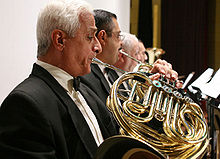
Baghdad has always played an important role in Arab cultural life and has been the home of noted writers, musicians and visual artists. Famous Arab poets and singers such as Nizar Qabbani, Umm Kulthum, Fairuz, Salah Al-Hamdani, Ilham al-Madfai and others wrote beautiful poems and sang for Baghdad.
The dialect of Arabic spoken in Baghdad today differs from that of other large urban centres in Iraq, having features more characteristic of nomadic Arabic dialects (Verseegh, The Arabic Language). It is possible that this was caused by the repopulating of the city with rural residents after the multiple sacks of the late Middle Ages.
Institutions
Some of the important cultural institutions in the city include:
- Iraqi National Orchestra – Rehearsals and performances were briefly interrupted during the Second Gulf War, but have since returned to normal.
- National Theatre of Iraq – The theatre was looted during the 2003 Invasion of Iraq, but efforts are underway to restore the theatre.
The live theatre scene received a boost during the 1990s when UN sanctions limited the import of foreign films. As many as 30 movie theatres were reported to have been converted to live stages, producing a wide range of comedies and dramatic productions.
Institutions offering cultural education in Baghdad include the Academy of Music, Institute of Fine Arts, and the Music and Ballet school Baghdad. Baghdad is also home to a number of museums which housed artifacts and relics of ancient civilization; many of these were stolen, and the museums looted, during the widespread chaos immediately after United States forces entered the city.
During the 2003 occupation of Iraq, AFN Iraq ("Freedom Radio") broadcast news and entertainment within Baghdad, among other locations. There is also a private radio station called "Dijlah" (named after the Arabic word for the Tigris River) that was created in 2004 as Iraq's first independent talk radio station. Radio Dijlah offices, in the Jamia neighbourhood of Baghdad, have been attacked on several occasions.
Sport
Baghdad is home to some of the most successful football (soccer) teams in Iraq, the biggest being Al Quwa Al Jawiya (Airforce club), Al Zawra, Al Shurta (Police), and Al Talaba (Students). The largest stadium in Baghdad is Al Shaab Stadium which was opened in 1966. Another, but much larger stadium, is still in the opening stages of construction.
The city has also had a strong tradition of horse racing ever since World War I, known to Baghdadis simply as 'Races'. There are reports of pressures by the Islamists to stop this tradition due to the associated gambling.
Major streets
Source: stripes.com
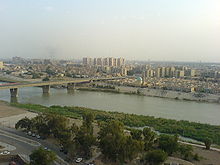
- Haifa Street
- Salihiya Residential area - situated off Al Sinak bridge in central Baghdad,surrounded by Al- Mansur Hotel in the north and Al-Rasheed hotel in the south.
- Hilla Road – Runs from the south into Baghdad via Yarmouk (Baghdad)
- Caliphs Street – site of historical mosques and churches.
- Sadoun Street – stretching from Liberation Square to Masbah
- Mohammed Al-Qassim highway near Adhamiyah
- Abu Nuwas Street – runs along the Tigris from the from Jumhouriya Bridge to 14 July Suspended Bridge
- Damascus Street – goes from Damascus Square to the International Airport Road
- Mutanabbi Street – A street with numerous books, named after the 10th century Iraqi poet Al-Mutanabbi
- Rabia Street
- Arbataash Tamuz (14th July) Street ( Mosul Road)
- Muthana al-Shaibani Street
- Bor Saeed (Port Said) Street
- Thawra Street
- Al Qanat Street – runs through Baghdad north-south
- Al Khat al Sare'a – Mohammed al Qasim (high speed lane) – runs through Bagdhad, north-south
- Al Sinaa Street (Industry Street) runs by the University of Technology – centre of computers trade in Baghdad.
- Al Nidhal Street
- Al Rasheed Street – city centre Baghdad
- Al Jamhuriah Street – city centre Baghdad
- Falastin (Palestine) Street
- Tariq el Muaskar – (Al Rasheed Camp Road)
- Baghdad Airport Road
Sister cities
Villages
- Amnish
